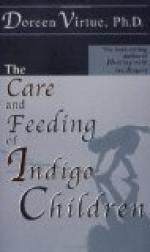Is it better to obtain the 10-per-cent milk by using a mixture of milk and cream, or as top-milk?
If one can get milk fresh from the cows, the top-milk is to be preferred on account of freshness. The food can then be made up when the milk is but a few hours old. In cities, if one uses bottled milk, the upper third may also be used. But if one buys milk and cream separately, it is usually more convenient to mix these, as the cream will not rise upon milk a second time with any uniformity.
How can one obtain formulas in which the fat is twice the proteids?
By using for dilution a 7-per-cent milk (i.e., milk containing 7 per cent fat) which serves as the primary formula from which all the other formulas of this series are derived.
In 7-per-cent milk the fat is just twice the proteids.
How can one get the 7-per-cent milk?
(1) As top-milk, as described on page 64; or, (2) by mixing three parts of milk and one part of ordinary (16 per cent) cream; (3) from any of the milk laboratories it may be obtained directly. As in the case of 10-per-cent milk, the top-milk is generally to be preferred to a mixture of milk and cream.
How should the food be prepared during the early months?
It is convenient in calculation to make up twenty ounces of food at a time. The first step is to obtain the 10-per-cent milk or the 7-per-cent milk to be used as the primary formula. Then to take the number of ounces of this that are called for in the formula desired.
Note.—One should not make the mistake of taking from the top of the bottle only the number of ounces needed in the formula as this may give quite a different result.
There will be required in addition one ounce of milk sugar[4] and one ounce of lime-water in each twenty ounces. The rest of the food will be made up of boiled water.
[4] If the milk sugar be measured in the milk-dipper, two scant dipperfuls may be calculated as one ounce. If measured in a tablespoon, three even tablespoonfuls may be calculated as one ounce.
These formulas written out would be as follows:
First Series
Formulas for the Early Months from 10-per-cent Milk
-------------------------------------------------------
---- I. II. III. IV. V. ----------------------------------------------------------- 10-per-cent milk 2 oz. 3 oz. 4 oz. 5 oz. 6 oz. Milk sugar 1 " 1 " 1 " 1 " 1 " Lime-water 1 " 1 " 1 " 1 " 1 " Boiled water 17 " 16 " 15 " 14 " 13 " ----------------------------------------------------------- 20 oz. 20 oz. 20 oz. 20 oz. 20 oz. -----------------------------------------------------------<
/pre>As the milk sugar dissolves in the water the total in each column will be exactly twenty ounces. The food is strengthened by gradually increasing the milk and reducing the water.




